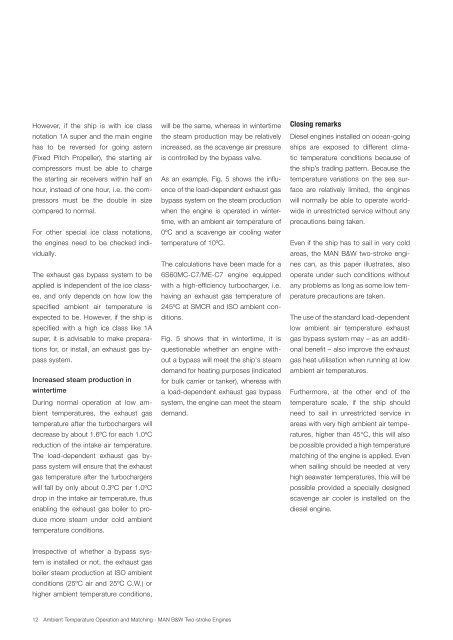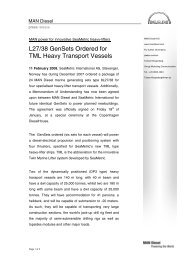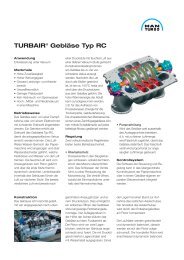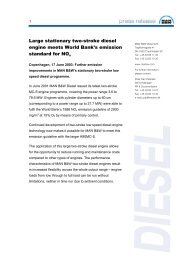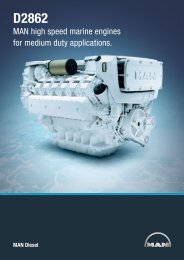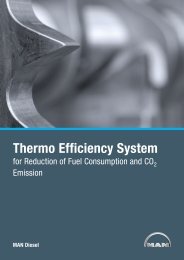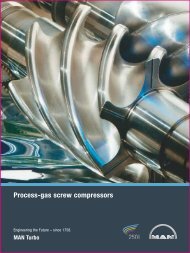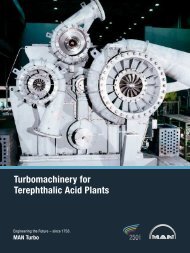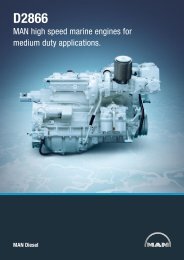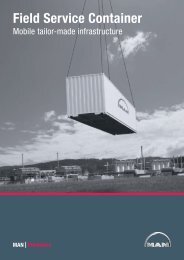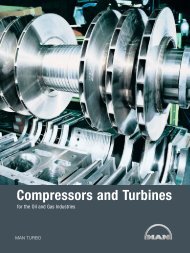Download file - MAN Diesel & Turbo SE
Download file - MAN Diesel & Turbo SE
Download file - MAN Diesel & Turbo SE
Create successful ePaper yourself
Turn your PDF publications into a flip-book with our unique Google optimized e-Paper software.
However, if the ship is with ice class<br />
notation 1A super and the main engine<br />
has to be reversed for going astern<br />
(Fixed Pitch Propeller), the starting air<br />
compressors must be able to charge<br />
the starting air receivers within half an<br />
hour, instead of one hour, i.e. the compressors<br />
must be the double in size<br />
compared to normal.<br />
For other special ice class notations,<br />
the engines need to be checked individually.<br />
The exhaust gas bypass system to be<br />
applied is independent of the ice classes,<br />
and only depends on how low the<br />
specified ambient air temperature is<br />
expected to be. However, if the ship is<br />
specified with a high ice class like 1A<br />
super, it is advisable to make preparations<br />
for, or install, an exhaust gas bypass<br />
system.<br />
Increased steam production in<br />
wintertime<br />
During normal operation at low ambient<br />
temperatures, the exhaust gas<br />
temperature after the turbochargers will<br />
decrease by about 1.6ºC for each 1.0ºC<br />
reduction of the intake air temperature.<br />
The load-dependent exhaust gas bypass<br />
system will ensure that the exhaust<br />
gas temperature after the turbochargers<br />
will fall by only about 0.3ºC per 1.0ºC<br />
drop in the intake air temperature, thus<br />
enabling the exhaust gas boiler to produce<br />
more steam under cold ambient<br />
temperature conditions.<br />
will be the same, whereas in wintertime<br />
the steam production may be relatively<br />
increased, as the scavenge air pressure<br />
is controlled by the bypass valve.<br />
As an example, Fig. 5 shows the influence<br />
of the load-dependent exhaust gas<br />
bypass system on the steam production<br />
when the engine is operated in wintertime,<br />
with an ambient air temperature of<br />
0ºC and a scavenge air cooling water<br />
temperature of 10ºC.<br />
The calculations have been made for a<br />
6S60MC-C7/ME-C7 engine equipped<br />
with a high-efficiency turbocharger, i.e.<br />
having an exhaust gas temperature of<br />
245ºC at SMCR and ISO ambient conditions.<br />
Fig. 5 shows that in wintertime, it is<br />
questionable whether an engine without<br />
a bypass will meet the ship's steam<br />
demand for heating purposes (indicated<br />
for bulk carrier or tanker), whereas with<br />
a load-dependent exhaust gas bypass<br />
system, the engine can meet the steam<br />
demand.<br />
Closing remarks<br />
<strong>Diesel</strong> engines installed on oceangoing<br />
ships are exposed to different climatic<br />
temperature conditions because of<br />
the ship’s trading pattern. Because the<br />
temperature variations on the sea surface<br />
are relatively limited, the engines<br />
will normally be able to operate worldwide<br />
in unrestricted service without any<br />
precautions being taken.<br />
Even if the ship has to sail in very cold<br />
areas, the <strong>MAN</strong> B&W two-stroke engines<br />
can, as this paper illustrates, also<br />
operate under such conditions without<br />
any problems as long as some low temperature<br />
precautions are taken.<br />
The use of the standard loaddependent<br />
low ambient air temperature exhaust<br />
gas bypass system may – as an additional<br />
benefit – also improve the exhaust<br />
gas heat utilisation when running at low<br />
ambient air temperatures.<br />
Furthermore, at the other end of the<br />
temperature scale, if the ship should<br />
need to sail in unrestricted service in<br />
areas with very high ambient air temperatures,<br />
higher than 45°C, this will also<br />
be possible provided a high temperature<br />
matching of the engine is applied. Even<br />
when sailing should be needed at very<br />
high seawater temperatures, this will be<br />
possible provided a specially designed<br />
scavenge air cooler is installed on the<br />
diesel engine.<br />
Irrespective of whether a bypass system<br />
is installed or not, the exhaust gas<br />
boiler steam production at ISO ambient<br />
conditions (25ºC air and 25ºC C.W.) or<br />
higher ambient temperature conditions,<br />
12 Ambient Temperature Operation and Matching - <strong>MAN</strong> B&W Two-stroke Engines


